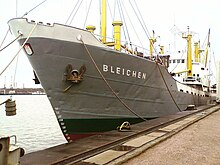Bleaching (ship)
|
||||||||||||||||||||||||
|
||||||||||||||||||||||||
|
||||||||||||||||||||||||
|
||||||||||||||||||||||||
|
||||||||||||||||||||||||
The bleaching is a museum ship in the port of Hamburg , which takes its Hansa Harbor at Bremer quay in front shed 50 berth has. The ship, built in 1958, is a typical general cargo ship of its time and lies in front of the listed general cargo storage shed used by the port museum .
history
The museum ship was built at the Nobiskrug shipyard in Rendsburg for the Hamburg shipping company HM Gehrckens (HMG) and put into service under the name Bleichen . Like its sister ship Borgesch, the ship was named after an old Hamburg street. The Bleichen was a typical general cargo ship, as it was in use before the advent of container ships . The shipping company Gehrckens used their ships in the Scandinavian trade . The Bleichen was therefore built with a high ice class in order to be able to sail the Baltic Sea all year round. The ship transported paper from Finland to Germany until 1970. In 1970 it was named Canale Grande from the new Italian owner . The Canale Grande was bought by a Turkish shipowner in 1979 and renamed Arcipel . The ship was used from 1994 to December 2006 under the name Old Lady for the transport of bulk cargo in the Black Sea .
Due to the construction as a three-island ship and the complex operation, the operation of the ship was no longer profitable. The bleaching had relatively small hatches and tween decks , so for today's conditions, the loading and deletion was inefficient. With a crew of 22 men, it took three days before 2,000 tons of scrap could be loaded. The ship was to be decommissioned and scrapped .
The Hamburg Maritime Foundation , which was looking for a general cargo ship for its museum at the 50s shed , the last remaining quay shed in Hamburg from the time of the German Empire , became aware of the ship in 2006 and decided to buy it. The purchase price of 450,000 euros was raised through donations. After a stay in the shipyard in Turkey, it was transferred to Hamburg in January 2007, where it arrived on January 30, 2007.
On April 27, 2007, the Old Lady was christened back on her first ship name Bleichen . Since then it has been sailing under the German flag again with its home port of Hamburg.
The ship
The Bleichen has midship and stern superstructures, a deck design that went out of fashion in the 1950s, but guaranteed a high level of comfort in the middle bridge, as it was less affected by vibrations and noise from the engine. Despite its age, the ship is largely unchanged and in good condition. The marine diesel engine from Klöckner-Humboldt-Deutz has been preserved unchanged, as have the steering gear , the lifeboats and the propellers . According to earlier crew members, the interior is still in its original condition.
plans
For restoration and operation, a company association “Friends of the general cargo carrier MS Bleichen” was founded on February 6, 2007. The ship can be viewed regularly during the opening hours of the port museum. The restoration is to be carried out by volunteers as well as by the project “Youth in Work”. The restoration time was estimated at about three years, but it took longer. Defects were found in the midship superstructure and the main engine, the rectification of which will take more time than expected.
Trial and acceptance drive
On October 24, 2017, the test run of the Bleichen was successfully carried out on the Elbe . From 2018 there will be guest trips again.
See also
Web links
swell
- ↑ Taz Hamburg of January 30, 2007
- ^ Friends of the general cargo carrier MS Bleichen eV
- ^ Youth in Work Hamburg eV
- ↑ Test and acceptance run of the Bleichen successfully carried out on October 24, 2017.
- ↑ The historic general cargo ship “MS Bleichen” is back on the road
Coordinates: 53 ° 31 ′ 37.1 ″ N , 10 ° 0 ′ 1.1 ″ E



